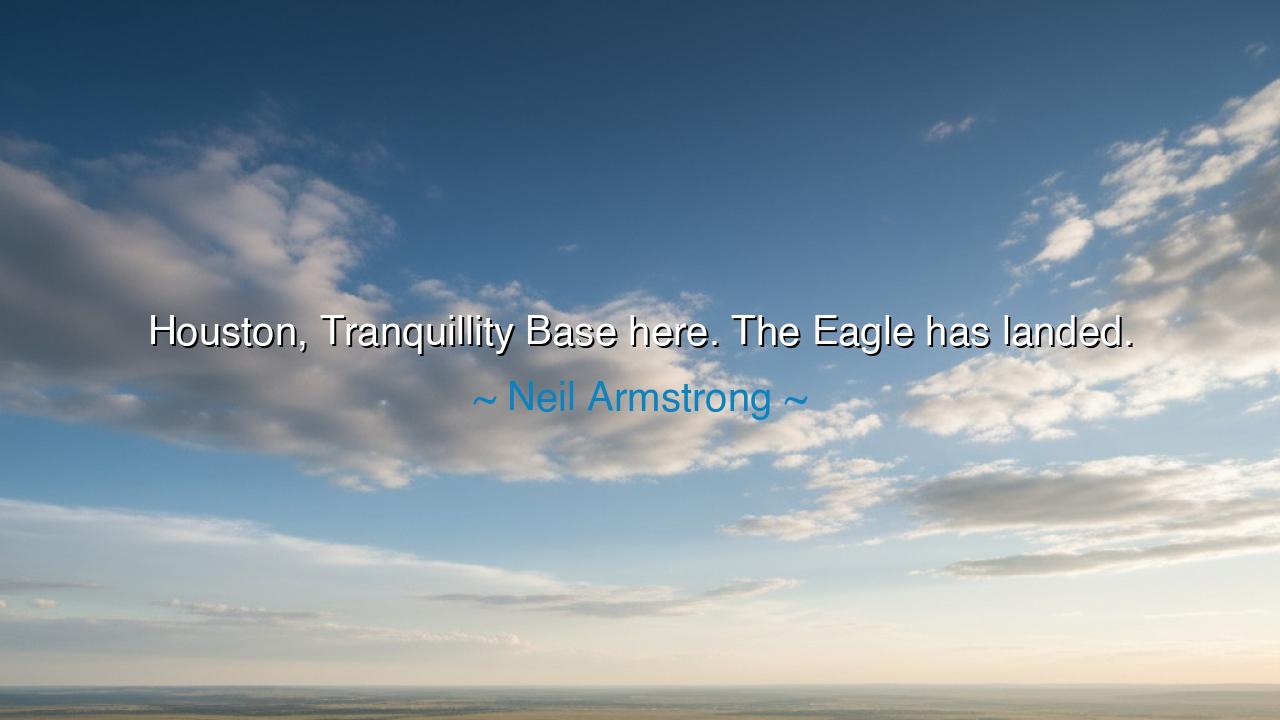
Houston, Tranquillity Base here. The Eagle has landed.






In the annals of human history, few moments have been as transformative and as filled with wonder as the first steps taken by Neil Armstrong on the surface of the moon. The phrase, "Houston, Tranquillity Base here. The Eagle has landed," marks the moment when humanity accomplished what was once thought to be impossible—a feat so extraordinary that it would echo through the ages. These words were not just a declaration of arrival, but a triumph of human spirit, perseverance, and vision. In those few words, Armstrong encapsulated the culmination of centuries of dreams, labor, and unyielding curiosity.
For centuries, the heavens above were seen as the realm of gods and mysticism. The Greeks believed that the stars were not only points of light in the sky but the homes of their most revered deities. Homer’s epic tales of the Iliad and the Odyssey filled the heavens with gods who guided the fates of men, weaving destinies among the stars. Yet, while the ancients viewed the stars as divine and beyond reach, the dream of touching the heavens was never far from the hearts of those who would come after. The Renaissance brought a new understanding of the cosmos, and by the time Armstrong uttered those fateful words, humanity was on the cusp of transforming from a species that looked up to the heavens with awe to one that would stand upon them.
The landing of the Eagle, the spacecraft that carried Armstrong and Buzz Aldrin to the lunar surface, was not merely a technical achievement—it was a symbol of what humanity could accomplish when it dared to dream beyond the confines of the Earth. Armstrong’s words, "The Eagle has landed," were not just a statement of arrival but an acknowledgment of the magnitude of the journey. They were a tribute to the courage of those who built the spacecraft, to the visionaries who believed that humanity could reach the stars, and to the millions of people who, for years, dreamed and worked toward this day. In that moment, Armstrong and Aldrin became the representatives of all of humanity, standing on a distant world, united in purpose and hope.
Consider the ancient explorers who first set sail across the vast, uncharted oceans, like Christopher Columbus or Ferdinand Magellan. They too faced the unknown, driven not by certainty, but by a profound belief that something beyond the horizon awaited them. Their ships were their Eagles, their courage their guiding force. Just as Columbus called out to his crew when he first spotted land, so too did Armstrong speak to the world, calling attention to the great voyage that had brought humanity to the moon. Both Columbus and Armstrong stood as symbols of the same human impulse: the drive to push beyond the limits of what was known and to reach for what was seemingly impossible.
The phrase, “The Eagle has landed,” also holds deep symbolism in its connection to the Eagle, an animal revered across cultures as a symbol of freedom, strength, and vision. To speak of an eagle landing on the moon was not merely to speak of a spacecraft's descent, but to call upon the spirit of elevated thought, of a species that could soar above the mundane and envision greatness. The eagle represents the soaring spirit of humanity—the ability to rise above limitations and rise to challenges that seem insurmountable. In the act of landing on the moon, humanity fulfilled a long-held desire to reach beyond the confines of the Earth, and in doing so, symbolized the boundless potential of the human spirit.
So, what can we take from Armstrong’s words? The lesson is clear: humanity is defined not by what it has already achieved, but by its ability to dream, to reach beyond the known, and to take action in pursuit of those dreams. The landing of the Eagle on the moon was not just a technological feat—it was a triumph of the human spirit, a spirit that continues to push the boundaries of possibility. It tells us that there are no limits, except those we place upon ourselves. Whether we seek to land on the moon or to achieve something more personal, the journey requires courage, vision, and resilience.
In our own lives, let us be inspired by Armstrong’s words. Let us not be afraid to dream big, to push beyond the boundaries of what we know, and to take action in the face of uncertainty. As we each work toward our goals—whether they be as monumental as landing on the moon or as personal as achieving our greatest potential—let us remember that the same human spirit that carried Armstrong to the lunar surface flows within each of us. We are all, in our own way, standing on the edge of a great journey, and the Eagle is ready to land. We must take the leap, knowing that the stars above are waiting for us to reach for them.






AAdministratorAdministrator
Welcome, honored guests. Please leave a comment, we will respond soon